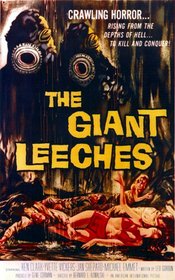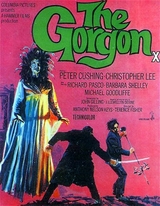Our editor-in-chief Nate Yapp is proud to have contributed to the new book Hidden Horror: A Celebration of 101 Underrated and Overlooked Fright Flicks, edited by Aaron Christensen. Another contributors include Anthony Timpone, B.J. Colangelo, Dave Alexander, Classic-Horror.com's own Robert C. Ring and John W. Bowen. Pick up a copy today from Amazon.com!
Attack of the Giant Leeches (1959)
The word “leech” carries a pejorative meaning that describes anyone or anything with parasitical qualities. People or objects that “hang on” unwittingly may be known as “leeches”. Through this lens, one should view 1959’s schlock gem Attack of the Giant Leeches, which was co-produced by the Corman brothers, Roger and Gene.
In the Florida Everglades, a backwoods poacher stumbles upon a bizarre creature while tramping through the swamps: the size of an adult with tentacle-like suckers, this featured creature defies categorization. The poacher reports this news to his small community of rednecks, but nobody believes him. Meanwhile, the equatorial Dave Walker, who owns the local bar, catches his adulterous vixen of a wife neckin’ (in the swamp of course) with a local stud; Walker stalks the lovers with a shotgun through the wetlands, and the hunt climaxes with a giant leech attacking the lovers. Soon thereafter, more locals are missing. The sheriff and game warden investigate and discover an underwater cavern where victims are detained so giant leeches can suck their blood. Reluctantly, the locals blow up the swamp to save the community from its disgusting fate. But is it too late?
As with many Corman films, interesting themes abound. The depiction of an all-white community of backwoods hillbillies was rare for 1959. Watching grown men utter the stereotypical Southern drawl, sip moonshine, wear overalls, and crack moronic jokes revealed a slice of America film viewers were not accustomed to in 1959. Doc Greyson, the local sheriff, captures the spirit of this stubborn good ol’ boy mentality: he wants things done one way only, his way, anchored in tradition…the Southern way.
According to the film’s tagline, “Rising from the depths of hell to kill and conquer,” the leeches are hilarious and resemble people wearing rubber suits or black garbage bags with strange “suckers” painted on them. The few scenes of victims in the lair growing pale from blood loss are unnerving, as they resemble zombies (it’s hard not to recall Romero’s Night of the Living Dead, released nine years later, with its Southern characters, zombies, unidentifiable disaster, and black and white footage). What creates suspense and works in the leeches’ favor is that nobody asks or knows why they surfaced: at one point, a character wonders if the swamp’s proximity to Cape Canaveral is the reason. Such comments remind viewers of the film’s historical context: the Cape Canaveral reference should conjure the space race between America and the Soviet Union, which burned Cold War fears into many souls. Furthermore, the way leeches drain energy from their victims is reminiscent of how many Americans felt Communists, lurking in shadowy undergrounds, sucked the vitality from American ideals.
With She Demons of the Swamp as an alternative title (others included Attack of the Blood Leeches, Demons of the Swamp, and The Giant Leeches), one cannot overlook the film’s commentary on gender. It depicts Yvette Vickers, the sexpot who plays Walker’s wife, as a lecherous parasite, and the weird love triangle between Walker, his wife, and her lover early in the film is honky-tonk at its best. Why would such a sexy woman (in 1959, Vickers was a Playboy centerfold) marry such a rotund man if not for his money? The film also introduces the “promiscuity will get you killed” theme that became standard fare in many 70s and 80s slasher flicks. Vickers’s libido, the leeches’ eroticism, and the film’s darkness, black and white photography, swampy humidity, and claustrophobic mood cast a strange sexual aura throughout the film.
Additionally, Leeches spins an interesting environmental slant, and Steve Benton, the game warden played by Ken Clark, best represents this eco-friendly message. His primary job is to apprehend poachers, and he, at least initially, refuses to blow up the swamp because such an explosion would destroy wildlife. However, his green thumb ultimately becomes a “thumbs down” as he reluctantly agrees to send dynamite into the lair. Throughout the film, a subtle underlying respect for the swamp and the way humans interact with it prevails. The film’s attempts at underwater footage are plentiful and try to convey the swamp’s underwater beauty; however, some shots seem to occur through aquarium-like glass.
With a notable musical score by Alexander Laszlo, Leeches is fun rainy-Saturday afternoon viewing. Borrowing frequently from Creature from the Black Lagoon, it celebrates all that’s funky about B-level creature features. Imagine this scenario: you’re 16-years-old, camping and partying with friends. Suddenly, a rustle in the woods scares everyone. However, you quickly realize the sound is actually a close friend you haven’t seen in years, eager to join your camp, carrying another case of beer and a fresh supply of junk food and other goodies. That friend is Leeches.









I found Ken Clark's character
I found Ken Clark's character to be an inept dullard.At first,he refuses to bring out the explosives because he doesn't want to disrupt the surrounding wildlife.However,it's already established that the leeches have driven off all the other creatures,but the filmmakers would have had a 30 minute feature on their hands.Yvette Vickers is a sight to behold,and the "local stud"(Michael Emmet)was the one who got to hold her.When her corpse floats to the surface,we are given the last truly haunting image to top the horrific scenes in the underwater cavern.Bruno VeSota had a rare opportunity to play a sympathetic role,and once he commits suicide at the film's midway point,the drama evaporates.If the idea of gigantic leeches seems implausible,at least the climax gives the impression that they survive,so the general hangdog surroundings contribute to an ending that actually makes sense.The Roger Corman touch always provided food for thought throughout the low budget 50's.
A fun movie for 1959. Yvette
A fun movie for 1959. Yvette Vickers at her best. Yvette should have been in serious presentations. Her acting in other movies is out standing as well. This B-grade film has turned into todays classic.